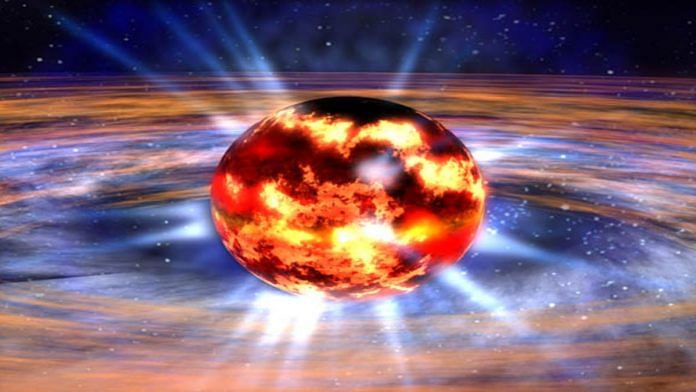Sound of ‘perfectly flowing fluid’ captured
A team led by a Massachusetts Institute of Technology (MIT) researcher has created and captured the sound of a perfect fluid — that flows with the smallest amount of friction.
Perfectly flowing liquids are rare on Earth. But, in deep space, it is thought to occur in the cores of neutron stars and in the plasma of the early universe.
Knowing what the perfect fluid sounds like could thus help scientists listen for signatures of neutron stars and even objects from the early universe, the researchers say.
The researchers were able to capture this sound by creating the perfect fluid in lab conditions. The team sent sound waves through this fluid — which was a gas that mimics the behaviour of elementary particles known as fermions that, theory suggests, are found in the cores of neutron stars.
Analysing thousands of sound waves traveling through this gas, the team measured how quickly sound dissipates in the gas — which gives clues about the material’s viscosity, or internal friction.
These sounds can now be used as a model of other, more complicated perfect flows, to estimate the viscosity of the plasma in the early universe — a value that would have otherwise been hard to calculate. More on New Scientist.
Also Read: Discovery of hidden microbes on Da Vinci drawings could help preserve them better
Supercomputer simulates how the Moon was formed
A team of scientists led by researchers at Durham University, UK, have used a supercomputer to make a simulation video of how the Moon formed as a result of a collision between the early Earth and another massive object 4.5 billion years ago.
Many researchers believe that a Mars-sized planet called Theia crashed into the Earth, and the debris from this collision led to the formation of the Moon.
For their experiment, the researchers ran supercomputer simulations to send a virtual Theia crashing into the early Earth.
They then ran simulations to track material from the early Earth and Theia for four days after the collision. The simulated collision produced different results depending upon the size and direction of Theia’s initial spin.
Their simulations produced an orbiting body that could potentially evolve into a Moon-like object.
While this research is not definitive proof of the Moon’s origin, it could be a promising stage in understanding how our satellite was formed. More on The Daily Express.
AI system solves decades-old challenge, predicts how proteins fold
An artificial intelligence (AI) system devised by British company DeepMind has solved a 50-year-old grand challenge that is referred to as the “protein folding problem”.
The system, AlphaFold, could be a breakthrough in accelerating biological research over the long term, possibly paving the way for understanding diseases and discovering new drugs.
Proteins are essential to life and their shapes are closely linked with their functions. The ability to predict protein structures enables a better understanding of what they do and how they work. Developing new treatments for diseases or finding enzymes that break down industrial waste are all problems that are fundamentally tied to proteins and the role they play.
There are currently over 200 million proteins in the main database and only a fraction of their 3D structures have been mapped out.
The latest AlphaFold system achieves unparalleled levels of accuracy in predicting protein structures. The system is able to determine highly-accurate structures in a matter of days.
Currently, determining protein shapes and functions is a major field of scientific research. It uses experimental techniques that can take years of work for each structure. More on Science Magazine.
Also Read: Bacteria could help extract minerals from rocks on Mars and Moon, study says
Around 3 million galaxies mapped in just 3 hours
The Australian Square Kilometre Array Pathfinder (ASKAP) radio telescope, developed and operated by Australia’s national science agency CSIRO, has mapped approximately three million galaxies in just 300 hours.
The resulting map has been described by researchers as a “Google map of the universe”. Most of the millions of star-like points on the map are distant galaxies — about a million of which have never seen before.
The telescope’s key feature is its wide field of view, generated by new CSIRO-designed receivers, that enable ASKAP to take panoramic pictures of the sky in amazing detail.
Using ASKAP at CSIRO’s Murchison Radio-astronomy Observatory (MRO) in outback Western Australia, the survey team observed 83 per cent of the entire sky. This result proves that an all-sky survey can be done in weeks rather than years, opening new opportunities for discovery. More on Space.
Life on Mars may have existed, but deep below surface
A study by US researchers suggests that if life ever existed on the planet Mars, it would have been several miles below the planet’s surface.
The surface of Mars has several indicators — ancient riverbeds, and water-related minerals — that suggest the red planet had abundant liquid water about 4.1 billion to 3.7 billion years ago.
But at the time, the Sun was much fainter, so the climate of early Mars should have been freezing.
The scientists examined several Mars datasets, and concluded that liquid water may have been stable at the time only at great depths. Therefore, life, if it ever originated on Mars, may have followed liquid water to greater depths. More on CNN.
Also Read: Medicinal plant evolves to hide from humans, blends in with environment where harvested






